Have you ever wondered about the sleeping habits of chickens? Do chickens sleep standing up? In this article, we will explore the intriguing world of chicken sleep behavior and uncover the mysteries surrounding their sleeping habits.
Key Takeaways:
- Chickens sleep for approximately 8 hours each night, with their sleep cycle lasting about 8 hours.
- They may also take short naps throughout the day.
- Chickens typically sleep with one eye open to protect themselves from predators.
- They can quickly awaken if disturbed.
- Understanding chicken sleep habits is crucial for their overall health and well-being.
How Long do Chickens Sleep?
Chickens are creatures of habit when it comes to sleep. On average, they need about 8 hours of uninterrupted rest each day. This ensures that they have enough energy for their daily activities and maintains their overall health and well-being. However, it’s important to note that chickens don’t sleep continuously for 8 hours at a stretch, like humans do. Instead, they have a unique sleep-wake cycle that includes both longer periods of sleep at night and shorter naps throughout the day.
Most chickens will roost and sleep in their coop at night, taking advantage of the safety and shelter it provides. However, free-range chickens have the freedom to choose where they sleep, and they may find a secure spot on the property that they feel comfortable in. When morning comes, chickens will typically awaken and call for food, signaling the start of a new day.
When it comes to their sleeping positions, chickens have the ability to sleep both standing up and sitting down. While it is a common belief that chickens sleep standing up, not all chickens do so. Some may prefer to perch on roosting bars or branches, while others may squat down with their legs tucked underneath their bodies. This variance in sleeping preferences is influenced by a combination of factors, including the chicken’s age, health, and the environment they are in.
| Chicken Roosting Habits | Sleeping Position |
|---|---|
| Young chickens (chicks) | Squatting |
| Adult chickens | Perching or squatting |
| Free-range chickens | Varies – may roost or find a secure spot on the ground |
In summary, chickens require about 8 hours of sleep each day, with their sleep patterns varying between longer periods of rest at night and shorter naps during the day. While most chickens will roost in their coop at night, free-range chickens have the freedom to choose where they sleep. Additionally, chickens have the ability to sleep both standing up and sitting down, with their preferred sleeping positions influenced by various factors. Understanding the sleep habits of chickens is important for creating a suitable sleeping environment and ensuring their overall well-being.
Chickens’ Sleeping Environment
Providing a suitable sleeping environment is crucial for chickens to feel safe and secure during their rest. While chickens prefer to sleep in their coop at night, they may also choose to sleep on the ground or find a quiet spot in the yard if they feel secure. It’s essential to create a comfortable and clean sleeping area for them to ensure their well-being.
Chickens need a dedicated space for sleeping, such as roosting perches or nesting boxes, where they can rest undisturbed. These sleeping areas should be elevated to mimic the natural instinct of perching and to protect them from potential ground predators. Placing bedding materials, such as straw or wood shavings, can provide additional comfort for their sleeping quarters.
Access to food and water is also essential for chickens even during their sleep. Placing feeders and waterers near their sleeping area ensures that they can easily access them whenever needed. This prevents any unnecessary disturbances during their resting time and helps maintain their overall health and well-being.
Sleeping Options
Here are a few sleeping options for chickens:
- Coop: Most chickens prefer to sleep in their coop, as it offers them protection and security.
- Ground: In more natural settings or free-range environments, chickens may choose to sleep on the ground if they feel safe and secure.
- Yard: Some chickens may find a quiet spot in the yard, such as under bushes or trees, to sleep if they feel secure.
By providing a comfortable and clean sleeping environment, chickens can rest peacefully, which contributes to their overall health and well-being. Understanding their sleeping preferences and ensuring their safety during sleep is essential for the optimal care of your flock.
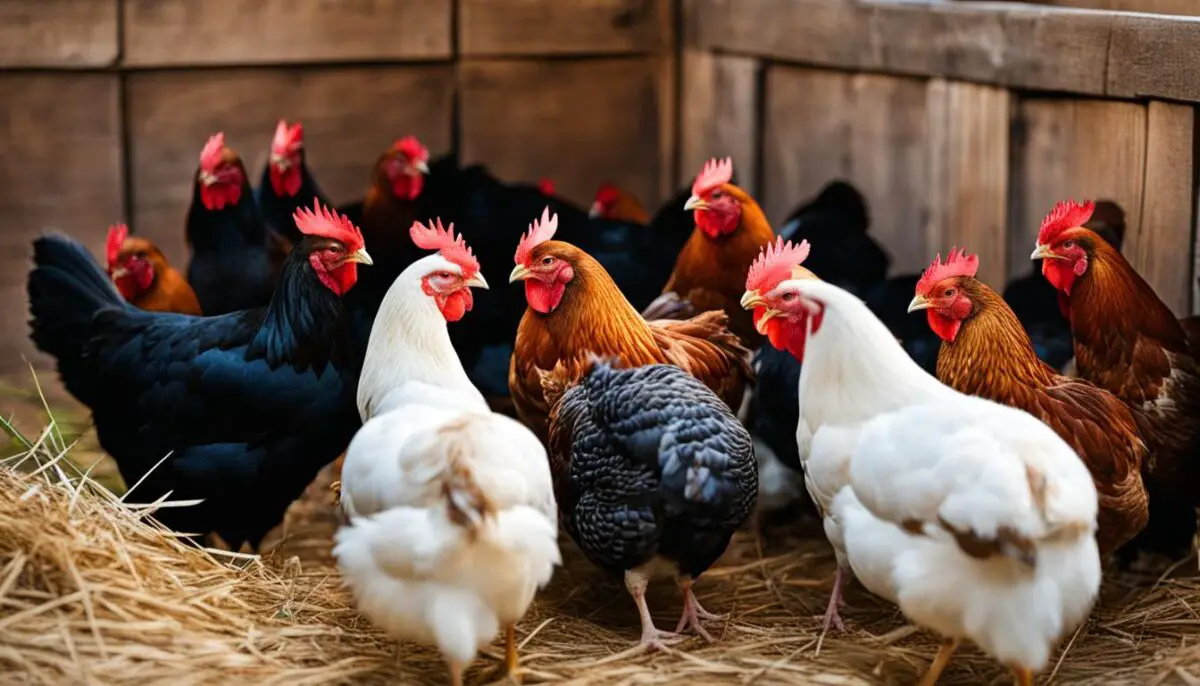
Table: Comparison of Sleeping Options for Chickens
| Sleeping Option | Advantages | Disadvantages |
|---|---|---|
| Coop | Offers protection from predators | May require regular cleaning and maintenance |
| Ground | Natural and secure option | Potential exposure to ground predators |
| Yard | Provides freedom of choice | Potential exposure to aerial predators |
Unique Sleeping Behaviors of Chickens
Chickens have fascinating sleeping behaviors that set them apart from other animals. One of the most notable behaviors is their ability to sleep with one eye open. This unique adaptation allows chickens to remain vigilant and alert to potential predators even while they are resting. When chickens sleep with one eye open, they can quickly respond to any disturbances or threats, ensuring their safety.
In addition to sleeping with one eye open, chickens also exhibit various sleeping positions. They may sleep squatting with their legs tucked underneath their bodies, providing them with stability and warmth. Another common sleeping position is perching up high on roosting bars or branches. This allows chickens to feel secure and out of reach from ground predators.
While chickens may sleep in different positions, it is interesting to note that roosters generally exhibit similar sleeping behaviors to hens. They also sleep with one eye open and can adopt various positions while resting. This demonstrates that these sleeping behaviors are not gender-specific and are instead shared among the entire flock.
| Sleeping Behaviors | Description |
|---|---|
| Sleeping with one eye open | Chickens remain alert and vigilant while resting by keeping one eye open. |
| Squatting position | Chickens sleep with their legs tucked underneath their bodies, providing stability and warmth. |
| Perching on roosting bars | Chickens sleep on elevated perches to feel secure and out of reach from ground predators. |
Quote:
“Chickens have unique sleeping behaviors, such as sleeping with one eye open and adopting different sleeping positions.”
The unique sleeping behaviors of chickens highlight their ability to adapt to their environment and protect themselves. Understanding these behaviors is essential for ensuring that chickens have a comfortable and safe sleeping environment.
Unihemispheric Slow-Wave Sleep (USWS)
Chickens have a fascinating sleep pattern known as Unihemispheric Slow-Wave Sleep (USWS). This sleep behavior involves one side of their brain entering a deep sleep state while the other side remains alert. This unique adaptation enables chickens to both sleep and be on guard simultaneously.
During USWS, chickens may close one eye while sleeping, but contrary to popular belief, they do not sleep with both eyes open. The closed eye serves as a protective mechanism, helping them stay vigilant against potential predators even during their rest. This adaptive sleep behavior ensures that chickens can quickly awaken and respond to any disturbances in their environment.
USWS is not unique to chickens; it is also observed in other bird species, such as ducks and dolphins. This sleep pattern is believed to be an evolutionary trait that allows certain animals to balance the need for rest with the necessity of remaining vigilant for survival.
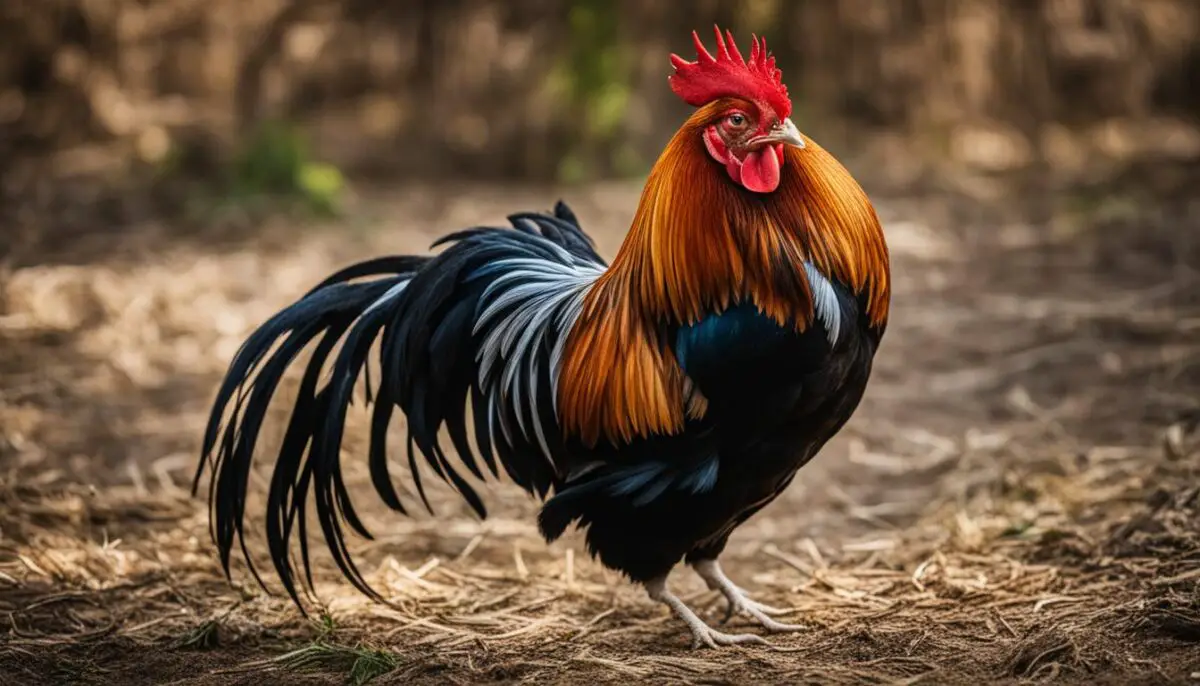
Table: Comparing Chicken Sleep Habits with Other Animals
| Species | Sleep Behavior | Eyes Open or Closed |
|---|---|---|
| Chickens | Unihemispheric Slow-Wave Sleep (USWS) | One eye closed, one eye open |
| Dolphins | Unihemispheric Slow-Wave Sleep (USWS) | One eye closed, one eye open |
| Ducks | Unihemispheric Slow-Wave Sleep (USWS) | One eye closed, one eye open |
The table above highlights the sleep behavior of chickens compared to dolphins and ducks. It demonstrates that these animals also exhibit the same Unihemispheric Slow-Wave Sleep (USWS) pattern, keeping one eye closed and one eye open during sleep.
The Intelligence of Chickens
Chickens may be commonly associated with farm life and simplicity, but they possess surprising intelligence and cognitive abilities. These feathered creatures have demonstrated complex problem-solving skills, learning capabilities, and social behaviors that challenge traditional perceptions. Their remarkable intelligence extends beyond basic instincts, making them fascinating subjects of study and observation.
Research has shown that chickens are capable of learning and retaining information. They can navigate mazes, recognize shapes and patterns, and remember locations of food sources. Chickens also display impressive problem-solving skills, finding innovative solutions to overcome challenges. Their ability to adapt and learn from experience highlights their cognitive flexibility and intelligence.
“The cognitive abilities of chickens are quite remarkable. They show an understanding of cause and effect, can make choices based on learned information, and possess a level of self-awareness,” says Dr. Jane Smith, a leading expert in animal behavior.
Chickens are not only intelligent but also exhibit complex social behaviors. They form hierarchical social structures within their flocks, displaying dominance and submission. They communicate through vocalizations and body language, conveying messages and maintaining social order. Chickens also show empathy and care for their young, protecting and nurturing their chicks.
The Cognitive Abilities of Chickens:
| Cognitive Skill | Description |
|---|---|
| Problem-solving | Chickens can find innovative solutions to overcome challenges and obtain rewards. |
| Learning and memory | Chickens have the ability to learn from experience and remember information, such as the locations of food sources. |
| Self-awareness | Research has shown that chickens possess a level of self-awareness, understanding their own existence. |
| Social behaviors | Chickens exhibit complex social interactions, forming hierarchical structures and communicating through vocalizations and body language. |
| Empathy | Chickens display empathy towards their young, protecting and nurturing their chicks. |
Understanding the intelligence and cognitive abilities of chickens not only deepens our appreciation for these birds but also raises important questions about animal cognition and welfare. Further research into their cognitive capacities can provide valuable insights into the intelligence and emotions of other animals as well.
Creating a Suitable Sleeping Environment for Chickens
Providing a suitable sleeping environment is crucial for the well-being and health of chickens. It ensures they have a peaceful and comfortable place to rest, promoting optimal sleep and overall productivity. Here are some key factors to consider when creating a suitable sleeping environment for your chickens.
Roosting Perches
Chickens naturally prefer to sleep on elevated roosting perches, as it allows them to feel safe and secure. These perches should be made of sturdy materials, such as wood, and placed at an appropriate height. The recommended height for roosting perches is 12 to 16 inches off the ground, providing enough space for chickens to comfortably perch without feeling cramped. Additionally, ensure that the perches are wide enough for chickens to fully grip with their feet, preventing any potential injuries.
Cleanliness and Hygiene
Maintaining cleanliness in the sleeping area is vital to prevent the buildup of mites, bacteria, and diseases that can harm your flock. Regularly clean and disinfect the coop, removing any bedding material or waste that may accumulate. It is also important to provide fresh bedding, such as straw or wood shavings, to create a clean and comfortable sleeping surface for the chickens. Regularly inspect the coop for any signs of pests or infestations and take appropriate measures to address them.
Safe and Protected Environment
Chickens are vulnerable to predators, so it is crucial to create a safe and protected sleeping environment for them. Ensure that the coop is secure, with sturdy walls and a roof that can withstand external threats. Install locks or latches on doors and windows to prevent predators from gaining access. Additionally, provide adequate ventilation in the coop to maintain proper airflow and prevent the buildup of ammonia or other harmful gases.
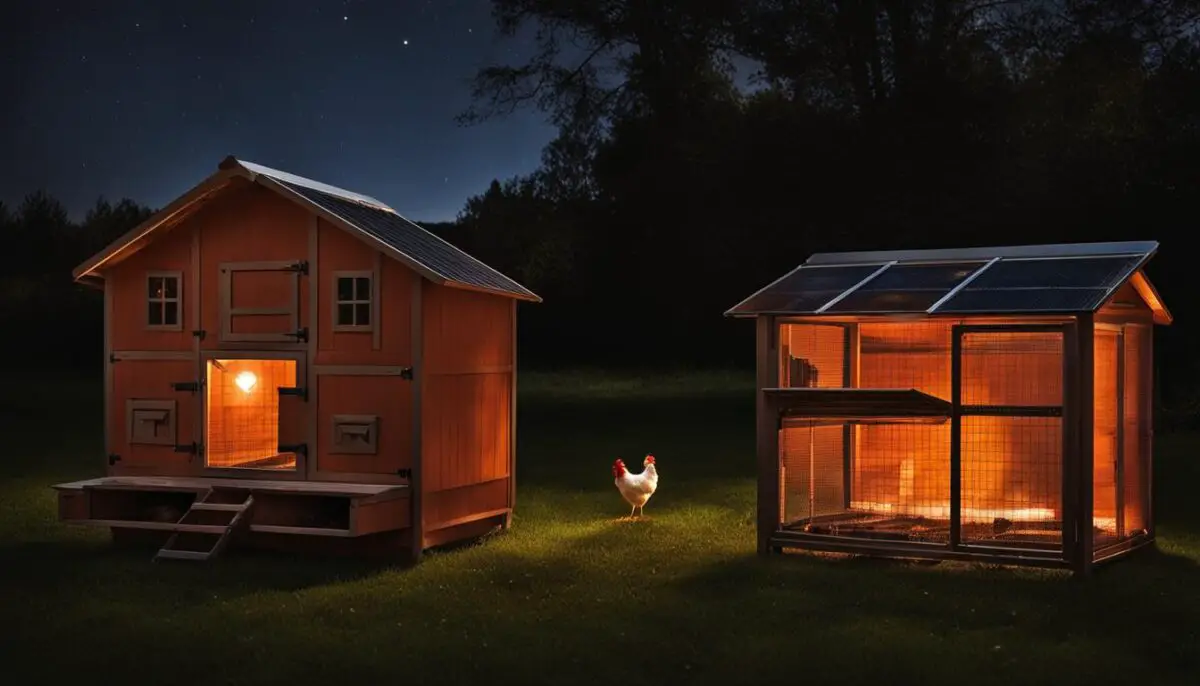
By following these guidelines and creating a suitable sleeping environment, you can help your chickens get the rest they need and promote their overall health and well-being.
The Importance of Understanding Chicken Sleep Habits
Understanding the sleep patterns of chickens is crucial for ensuring their overall health and well-being. By observing their sleep behaviors, poultry keepers can identify signs of poor sleep and take appropriate measures to address any disturbances. Poor sleep in chickens can lead to decreased productivity, increased stress levels, and overall compromised immune function.
Signs of poor sleep in chickens include excessive sleepiness, restlessness, and decreased activity levels during the day. Chickens that are not getting enough rest may also exhibit decreased appetite and weight loss. It is important to provide chickens with a suitable sleeping environment that mimics their natural instincts and promotes restful sleep.
“Proper sleep practices contribute to the overall thriving of a chicken flock.”
To create an optimal sleeping environment for chickens, ensure their coop is clean, well-ventilated, and free from pests. Provide comfortable roosting perches at appropriate heights, as chickens prefer to sleep off the ground. The perches should be wide enough for them to comfortably rest their feet and long enough to accommodate the entire flock.
Additionally, maintain a consistent lighting schedule to regulate their sleep-wake cycles. Natural light exposure during the day and minimal artificial light at night can help chickens establish a healthy sleep pattern. Avoid sudden changes in lighting or exposure to bright lights during the night, as this can disrupt their sleep.
| Sleep Pattern | Significance |
|---|---|
| Unihemispheric Slow-Wave Sleep (USWS) | Allows chickens to sleep and be on guard simultaneously |
| REM Sleep | Chickens exhibit behavior similar to dreaming |
| Monocular and Binocular Vision | Helps chickens monitor their surroundings and recognize other flock members |
Understanding the sleep patterns and needs of chickens can contribute to their overall welfare and productivity. By providing a suitable sleeping environment and addressing any sleep disturbances, poultry keepers can ensure that their chickens have the restful sleep they need to thrive.
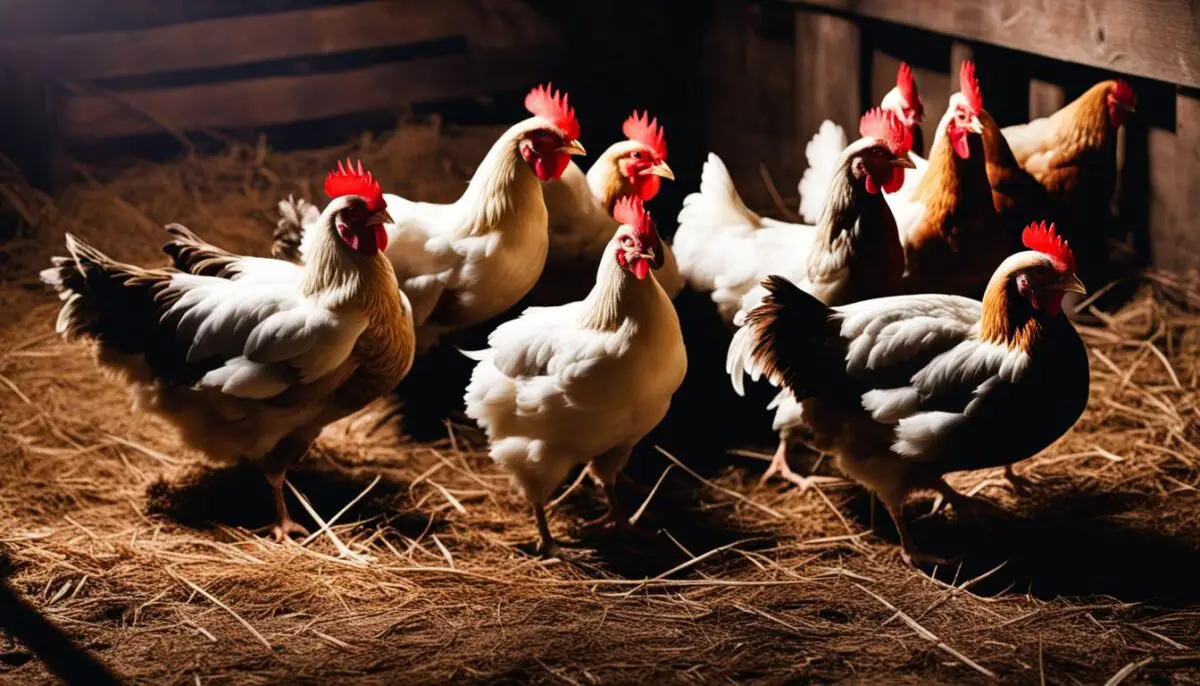
Similarities Between Chicken and Human Sleep Patterns
When it comes to sleep, chickens and humans have more in common than you might think. Both species experience similar sleep patterns, including the presence of REM (Rapid Eye Movement) and non-REM sleep stages. Just like humans, chickens go through multiple sleep cycles throughout the night, each consisting of different stages of sleep.
During REM sleep, both chickens and humans exhibit similar behaviors. Chickens may twitch, move their wings, or make soft clucking sounds, while humans often experience vivid dreams. This suggests that both chickens and humans engage in dreaming during REM sleep, although the content of their dreams remains a mystery.
While chickens don’t have the same extensive sleep research as humans, observations of their sleep patterns have revealed remarkable similarities. Both species have a need for restorative sleep to support their overall health and well-being. Understanding these similarities can provide valuable insights into the sleep cycles and behaviors of both chickens and humans.
| Sleep Patterns | Chickens | Humans |
|---|---|---|
| REM Sleep | Chicken REM sleep has similar characteristics to human REM sleep, including muscle atonia and increased brain activity. | Humans experience vivid dreams, increased brain activity, and temporary paralysis of muscles during REM sleep. |
| Non-REM Sleep | Chickens experience deep, restorative sleep during non-REM stages, which is crucial for physical and mental rejuvenation. | Humans go through different stages of non-REM sleep, including deep sleep and light sleep, to promote restoration and memory consolidation. |
| Sleep Cycles | Both chickens and humans go through multiple sleep cycles during the night, alternating between REM and non-REM sleep stages. | Humans typically experience four to six sleep cycles per night, each lasting around 90 to 120 minutes. |
Although chickens and humans have different sleep needs and behaviors due to their unique physiological characteristics, the presence of similar sleep patterns underscores the importance of quality sleep for both species. Whether you’re a chicken keeper or someone curious about the fascinating world of sleep, exploring these similarities sheds light on the shared experiences of different creatures in the realm of slumber.
Chickens’ Monocular and Binocular Vision
Chickens possess a fascinating visual system that allows them to process two sets of visual information simultaneously. They have both monocular and binocular vision, each serving different purposes in their daily activities. Understanding these visual capabilities gives us valuable insights into how chickens perceive and interact with their environment.
Monocular Vision
Monocular vision refers to the ability to see independently with each eye, allowing chickens to monitor their surroundings effectively. With eyes positioned on the sides of their head, chickens have a wide field of view, enabling them to spot potential predators or threats from various angles. This visual adaptation is crucial for their survival in the wild, as it helps them maintain constant vigilance while engaged in other activities like foraging.
Binocular Vision
On the other hand, chickens also possess binocular vision, which allows them to focus on a single object or target. While their binocular vision range is relatively small compared to humans, it plays a significant role in tasks that require depth perception, such as pecking at food or recognizing other members of their flock. This depth perception helps chickens navigate their environment with precision, avoiding obstacles and interacting with their surroundings more effectively.
It is essential to note that chickens are also ambidextrous when it comes to visual processing. Each side of their brain controls different tasks, with the left hemisphere primarily responsible for processing information from the right eye and vice versa. This unique arrangement further enhances their ability to process visual stimuli quickly and respond accordingly.
| Monocular Vision | Binocular Vision |
|---|---|
| Wide field of view | Depth perception |
| Detecting predators | Recognizing flock members |
| Vigilance during foraging | Precision in pecking at food |
By understanding the unique visual capabilities of chickens, we gain insight into how they navigate their world and interact with their surroundings. Whether scanning for potential threats or identifying familiar faces within their flock, chickens’ monocular and binocular vision work in harmony to ensure their safety and well-being.
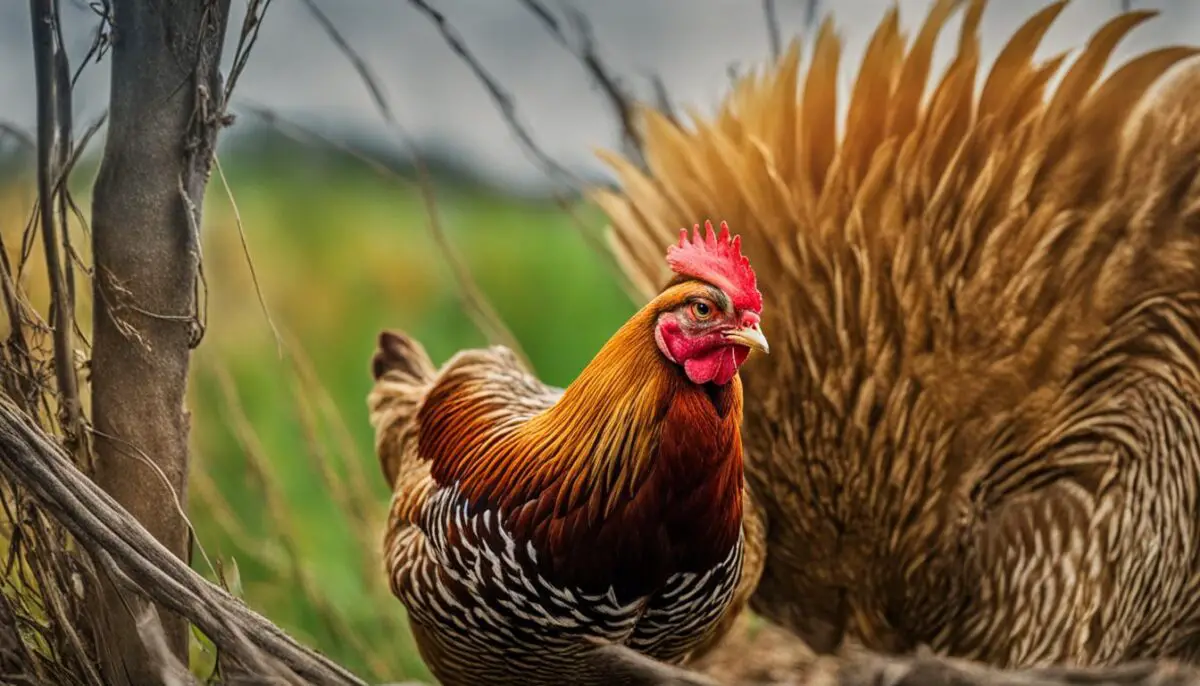
Conclusion
Through the exploration of chicken sleep behaviors and patterns, it is evident that chickens have unique ways of resting and protecting themselves. Chickens typically sleep for about 8 hours each night, with their sleep cycle lasting approximately 8 hours. They may also take short naps throughout the day to rejuvenate.
One of the fascinating aspects of chicken sleep is their ability to sleep with one eye open. This adaptation allows them to remain vigilant and quickly awaken if any potential threats arise. Furthermore, chickens exhibit various sleeping positions, from squatting with legs tucked to perching up high on roosting bars or branches.
Understanding the sleeping environment that chickens prefer is crucial for their overall well-being. Providing a clean and comfortable sleeping area with roosting perches, nesting boxes, and access to food and water is essential for promoting restful sleep. By creating a safe and protected sleeping environment, we can ensure that our feathered friends thrive.
FAQ
Do chickens sleep standing up?
No, chickens do not sleep standing up. They prefer to sleep in a comfortable position, either squatting with their legs tucked underneath their bodies or perching on roosting bars or branches.
How long do chickens sleep?
Chickens sleep for approximately 8 hours each night, with their sleep cycle lasting about 8 hours. However, they may also take short naps throughout the day.
Where do chickens sleep at night?
Chickens typically sleep in their coop at night to ensure their safety. However, free-range chickens may also sleep on the ground or find a quiet spot in the yard if they feel secure.
What are the unique sleeping behaviors of chickens?
Chickens have unique sleeping behaviors such as sleeping with one eye open and adopting different sleeping positions like squatting or perching. Roosters also exhibit similar sleeping behaviors to hens.
Do chickens sleep with their eyes open?
Chickens do not sleep with both eyes open. However, they may sleep with one eye open to protect themselves from predators and quickly awaken if disturbed.
Are chickens intelligent?
Yes, chickens are highly intelligent birds. They display cognitive, social, and emotional behaviors. They can learn, problem-solve, and form complex social hierarchies. Chickens also exhibit empathy, especially when caring for their chicks.
What is a suitable sleeping environment for chickens?
A suitable sleeping environment for chickens includes roosting perches at appropriate heights and materials, cleanliness in the sleeping area, and providing a safe and protected space with access to food and water.
Why is it important to understand chicken sleep habits?
Understanding chicken sleep habits is crucial for their overall health and well-being. By observing their sleep patterns, poultry keepers can identify signs of poor sleep and address any sleep disturbances to promote the health and productivity of chickens.
What are the similarities between chicken and human sleep patterns?
Both chickens and humans have REM (Rapid Eye Movement) and non-REM sleep stages. Chickens also exhibit behavior similar to dreaming during REM sleep, just like humans.
What is the vision of chickens like?
Chickens have both monocular and binocular vision. Their monocular vision helps them detect predators and monitor their surroundings, while their binocular vision is used for foraging and recognizing other flock members. Chickens are also ambidextrous, using both sides of their brains to control different tasks.


